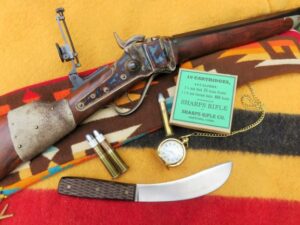
By Mike Nesbitt
Contributing Editor
While Sharps stories are some of my favorites, I’ve never told you about my favorite Sharps.
This is a rifle I might have, or must have, mentioned several times but I never actually told you the whole story about it. Let me correct that now while I tell you all I can about this fine rifle.
To begin with, this is a Semi Custom Classic Hartford Sporting Rifle by C. Sharps Arms. It’s in .44/77 caliber with a #1 Heavy 28″ barrel, complete with Hartford collar, and a pack-hardened reciever. I ordered it with no rear sight and no dovetail in the barrel for a rear sight. The tang sight was added to it before the rifle was bought. And the front sight is the standard nickel colored blade because I wanted this rifle more as a hunting gun than a target rifle, so its sights had to be visible in the woods. Along with having and using this rifle, I enjoy surrounding it with some almost “period correct” items that might be reflective of the buffalo hunting era.

The crescent “rifle” butt plate is available either in brass or as color case hardened steel. Authenticity played a big part in helping me choose between the steel or the brass butt plates. Both are good, certainly, as well as being equally attractive but most of the original Sharps rifles fitted with the “rifle” butt plates received brass. Often those brass butt plates were nickel plated. And along with the brass butt plate I requested brass escutcheons underneath the three screws that enter through the wood; the two screws in the bottom of the forearm and the rear lock screw that enters on the left side of the wrist. At C. Sharps Arms those brass escutcheons are available at no extra costs but they must be requested. The brass escutcheons also add to the authenticity of this rifle.
When my .44/77 was bought, it was equipped with a standard mid-range tang sight. My intentions for this rifle was to use it as a hunting arm more than a target rifle and while my hunting dreams have not come true with this gun, it still wears its “hunting sights.” Even so, this is the rifle that I used when entering a silhouette match for the first time. That was grand and I even got one “chicken.”
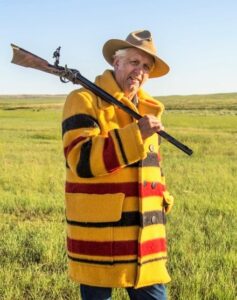
My score for that first try, using this rifle with rather full .44/77 loads and with the blade front sight, was eleven knock-downs and three of those were the rams at 500 meters. Shortly after that, I also used this rifle for my first try at Quigley. My score there was the same, eleven hits but none of them were hits on the “bucket.” (It took me three years to get an offhand hit on that “bucket!”) I can brag that I got three hits on the buffalo at 805 yards. Those experiences taught me that I needed a different front sight for such target work. My .44/77 still wears its blade front sight. Sometime, years ago now, the standard mid-range sight was replaced with a deluxe mid-range tang sight.
While I tend to show paper patched bullets in my pictures, because they are perhaps more reflective of the buffalo hunting era, the bullets I shot the most were actually “greasers.” Bullets from an Accurate Molds’ #44-400B get used a lot. Another favorite grease-groove bullet is from a Steve Brooks’ mold, for the 405 grain Original Postell style. My favorite load with either of those bullets uses 75 grains of GOEX’s discontinued Cartridge powder although I will quickly change to 75 grains of Olde Eynsford 1 1/2F powder when I run out of Cartridge powder. Other details about the loads include BPC Lube on the bullets and ignition is supplied by Federal standard large rifle primers.
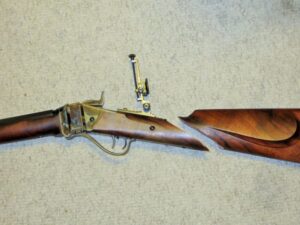
Then it happened, now seven years ago. I had been out shooting with my .44/77 and had returned home. Don’t ask me to recall if I was shooting in a match or just for fun, that’s been forgotten long ago. But I cleaned the rifle and then left it standing next to my desk. Next, while I was close to the desk but not sitting at it, there was the sound of my rifle falling and hitting the floor. That brought me to the desk area rather quickly and what I found was the rifle laying next to my chair, in two pieces. The butt stock had broken completely in two along that most attractive line in the grain just at the back of the wrist. I’ve been quite thankful that the break in the stock did not happen while I was firing the gun.
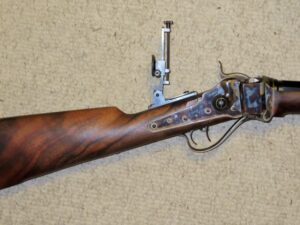
The break in the stock was examined and as luck would have it there were no splinters. No wood was missing. I sent a note to C. Sharps Arms and they told me to wrap the pieces carefully and send them to the shop as soon as possible. C. Sharps Arms rifles have a lifetime guarantee that basically covers everything except normal wear and abuse. So, the butt stock was removed from the rifle and sent back to Big Timber. About three weeks later, the “re-assembled” stock was sent back to me. The seam or glue line in the wood could be seen but you really had to be looking to find it. I was very pleased with the way the stock at been re-joined and that included some steel pins lengthwise in the wood to make the new bond much stronger than the way the stock originally was. My favorite .44/77 was home again and I continued to use it as before.
One of my reasons for wanting to keep the gun’s original stock was to keep the identity of the gun original too. This .44/77 is my most photographed rifle. The figure in the butt stock “fit right in” with the pack-hardened receiver. Those are the things that made me want to keep the rifle just the way it was, without obvious change.
Once at Quigley, when I was doing my shooting with the heavier .44/90, a fellow in our camp area announced that he’d decided on which version of a new C. Sharps Arms ’74 he was going to order.
“What’s that?” was asked, probably by several of us.
“I’ll get the Semi-Custom Classic Hartford Sporting Rifle.” he said. I replied, “Good choice, that’s what I have.”
“No you don’t,” he came back.
Rather than trying to argue with him, I stepped into the tent and brought out my .44/77. That other shooter’s eyes did light up a bit. Then I told him to take my rifle down to the C. Sharps Arms tent, located on “Traders’ Row,” and use it to show Pat Dulin what he wanted on his own Semi Custom rifle. While that fellow was walking down to the C. Sharps Arms tent he passed another group of shooters. One of those shooters commented as he walked by, “That’s Mike Nesbitt’s rifle.” So my .44/77 certainly had recognition. I’ll keep it the way it is as long as possible.
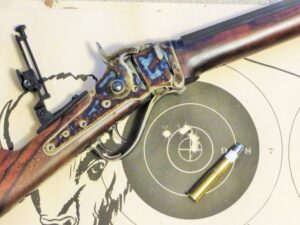
For shooting with paper patched bullets I favor a mold from KAL in Canada. The KAL molds are adjustable and mine is set to drop bullets at about 405 grains. Those bullets are given two wraps of paper, from Buffalo Arms Co., and loaded over 75 grains of Olde Eynsford 1 1/2F powder to duplicate the old Sharps loading. When put in an “old style” cartridge box, those loads don’t look bad at all. And they do shoot fairly well. My intention is to someday drop some game with this load. (That’s my fault, I’m just not getting out nowadays.)
Back to talking about my .44/77 for a bit, I know I’m not completely alone in favoring this caliber. While .44/77 shooters are not as numerous as .45/70 shooters, there is still a good batch of black powder cartridge shooters who appreciate the old .44s. One of those who likes the .44/77 is an old partner of mine. We live about 100 miles apart but we still get together now and then for some good shooting. He liked my .44/77 enough that he ordered one from C. Sharps Arms that is almost a twin. He didn’t like the “rifle butt plate” so he ordered his with the military butt which is standard on the Hartford models. Our two rifles both have 28″ barrels and his has the taller long range sight.
More shooting has been done, certainly, but on one trip to the range I gripped the rifle and quickly felt that something was wrong. The stock was cracked at the wrist again. So the rifle was sent to C. Sharps while we pondered on whether to replace the stock or to mend it again. Let me admit it, I was in favor of mending it. Pat Dulin suggested wrapping the wrist with rawhide to strengthen the wood and to hide the repair if the job fixing it could be seen. To make a long story short, that’s what was done.
After getting it back I have shot it some more, photographed the rifle, and reviewed several books which show old Sharps rifles that were used on the frontier. A whole lot of those older rifles show stock repair and a number of them received rawhide wraps around those wounds. So, my good .44/77 now looks like a used gun… That’s what it is but it has been used with honor and it will continue to be used. The rifle with its rawhide wrap, carefully sewn on and held in place with some brass headed tacks give the gun a real “used with honor” look.
They did a nice job in added the wrap but I’ll admit that at first I didn’t really like it. Now that I’ve seen it for a while and have shot the rifle some more, I do like it. For one thing it certainly adds to the individual-ness of this rifle. After all, no one else has one exactly like it. I’ll be keeping this .44/77 a long time and if we meet in camp someday I’ll be glad to show it to you.



